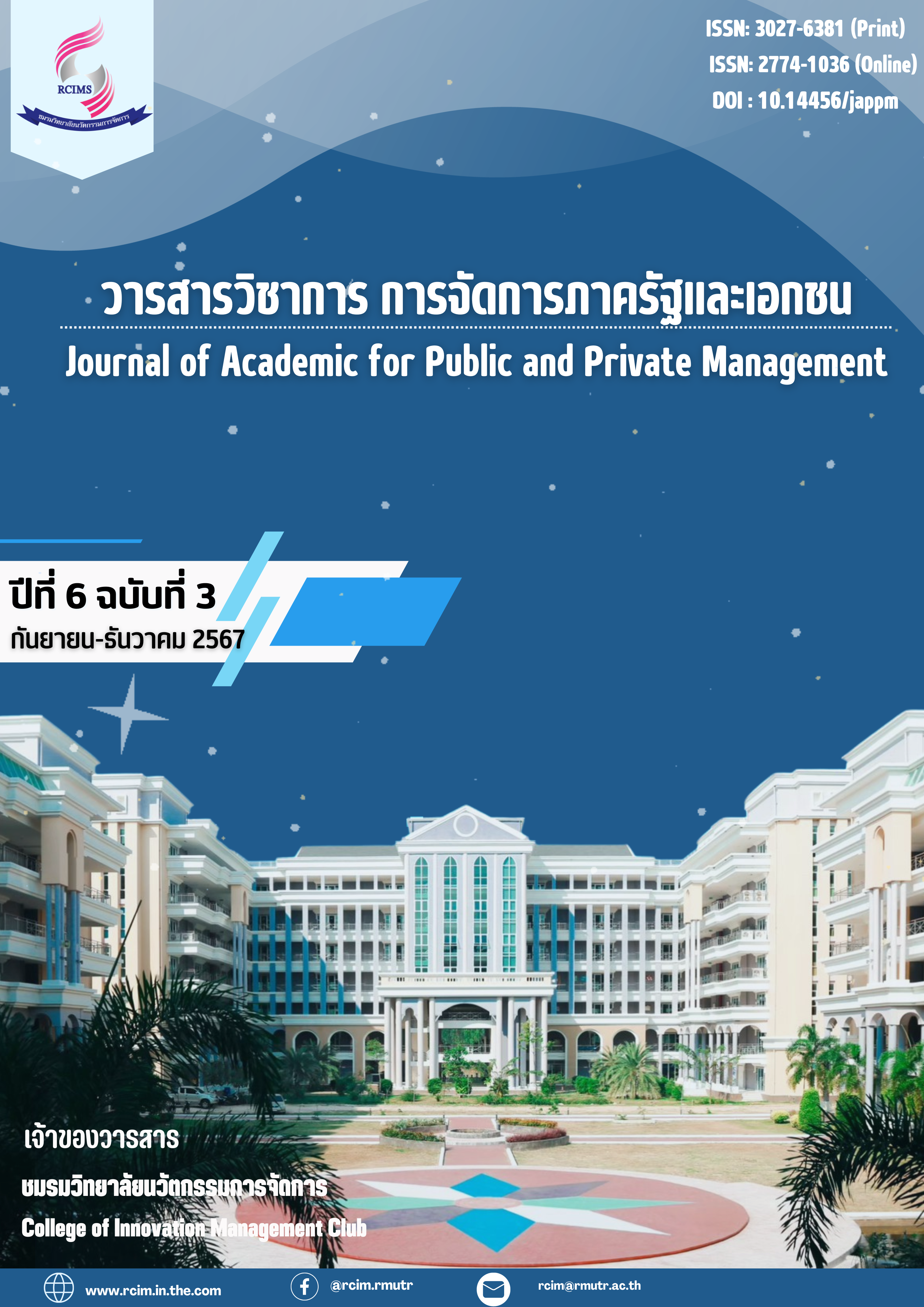อิทธิพลเชิงโครงสร้างของปัจจัยที่มีผลต่อการตัดสินใจเลือกใช้บริการสินเชื่อส่วนบุคคล กรณีศึกษาพนักงานในนิคมอุตสาหกรรมสินสาคร อำเภอเมืองสมุทรสาคร จังหวัดสมุทรสาคร
Main Article Content
บทคัดย่อ
บทความวิจัยนี้มีวัตถุประสงค์เพื่อศึกษา1)คุณภาพการให้บริการที่ส่งผลต่อความไว้วางใจ ความพึงพอใจของลูกค้า และการตัดสินใจเลือกใช้บริการ 2)ความไว้วางใจที่ส่งผลต่อความพึงพอใจของลูกค้าและการตัดสินใจเลือกใช้บริการ และ 3)ความพึงพอใจของลูกค้าที่ส่งผลทางตรงต่อการตัดสินใจเลือกใช้บริการสินเชื่อส่วนบุคคลของพนักงานในนิคมอุตสาหกรรมสินสาคร อำเภอเมืองสมุทรสาคร จังหวัดสมุทรสาคร ซึ่งการวิจัยนี้ได้มีรูปแบบของการวิจัยเชิงปริมาณ กลุ่มตัวอย่างที่ใช้ในการวิจัยเป็นพนักงานในนิคมอุตสาหกรรมสินสาคร อำเภอเมืองสมุทรสาคร จังหวัดสมุทรสาครที่เลือกใช้บริการสินเชื่อส่วนบุคคล จำนวน 270 ตัวอย่าง ใช้วิธีการคัดเลือกกลุ่มตัวอย่างแบบอย่างง่าย โดยมีแบบสอบถามเป็นเครื่องมือวิจัยและสถิติที่ใช้ในการวิจัย คือ การวิเคราะห์ด้วยค่าร้อยละ ค่าเฉลี่ย ส่วนเบี่ยงเบนมาตรฐาน และการวิเคราะห์สมการโครงสร้างด้วยโปรแกรมสำเร็จรูปทางสถิติ
ผลการวิจัยพบว่า 1)คุณภาพการให้บริการส่งผลทางตรงต่อความไว้วางใจ ความพึงพอใจของลูกค้า และการตัดสินใจเลือกใช้บริการ มีค่าสัมประสิทธิ์เส้นทางเท่ากับ 0.803, 0.212 และ 0.192 ตามลำดับ และคุณภาพการให้บริการส่งผลทางอ้อมต่อความพึงพอใจของลูกค้าและการตัดสินใจเลือกใช้บริการ มีค่าสัมประสิทธิ์เส้นทางเท่ากับ 0.601, 0.487 2)ความไว้วางใจส่งผลทางตรงต่อความพึงพอใจของลูกค้าและการตัดสินใจเลือกใช้บริการ มีค่าสัมประสิทธิ์เส้นทางเท่ากับ 0.748 และ 0.436 แต่ความไว้วางใจไม่ส่งผลทางอ้อมต่อการตัดสินใจเลือกใช้บริการ มีค่าสัมประสิทธิ์เส้นทางเท่ากับ 0.126 และ 3)ความพึงพอใจของลูกค้าไม่ส่งผลทางตรงต่อการตัดสินใจเลือกใช้บริการ มีค่าสัมประสิทธิ์เส้นทางเท่ากับ 0.168
Article Details

อนุญาตภายใต้เงื่อนไข Creative Commons Attribution-NonCommercial-NoDerivatives 4.0 International License.
เอกสารอ้างอิง
ธนาคารแห่งประเทศไทย. (2565). รายงานผลการสำรวจภาวะและแนวโน้มสินเชื่อ. ค้นเมื่อ 25 กันยายน, 2566, จาก https://www.bot.or.th/content/dam/bot/documents/th/thai-economy/econ-publication/credit-conditions-report/LoanSurvey-TH-2565-Q4.pdf.
ธนาคารแห่งประเทศไทย. (2566). รายงานข้อมูลสินเชื่อธุรกิจภายใต้การกำกับของธนาคารแห่งประเทศไทย. ค้นเมื่อ 25 กันยายน, 2566, จาก https://app.bot.or.th/BTWS_STAT/statistics/BOTWEBSTAT. aspx?reportID=907&language=TH.
ปรมน ปัญญาไตรรัตน์ และธัญนันท์ บุญอยู่. (2565). รูปแบบการดำเนินชีวิตและนวัตกรรมที่มีผลต่อการตัดสินใจซื้ออาหาร Meal Kit ของผู้บริโภคในยุคฐานวิถีชีวิตใหม่ (New Normal) ในเขตกรุงเทพมหานคร. วารสารวิทยาการจัดการปริทัศน์, 24(1), 43-53.
ศรินภัสร์ ล้อมวลีรักษ์, ภาศิริ เขตปิยรัตน์ และศิริกานดา แหยมแดง. (2565). ปัจจัยส่วนประสมทางการตลาดและคุณภาพการให้บริการที่มีอิทธิพลต่อความพึงพอใจของลูกค้าบริษัทห้องเย็นอุตรดิตถ์จำกัด. วารสารวิชาการจัดการภาครัฐและเอกชน, 4(3), 91-105.
สมโชค นินเป้า. (2565). การวิเคราะห์ปัจจัยเชิงสาเหตุในการใช้บริการแพลตฟอร์มสินเชื่อรถยนต์ในประเทศไทย. วิทยานิพนธ์บริหารธุรกิจมหาบัณฑิต, มหาวิทยาลัยนเรศวร.
Chou, P. F. (2014). An evaluation of service quality, trust, and customer loyalty in home-delivery services. International Journal of Research in Social Sciences, 3(8), 99-108.
Chou, S. K., Kohsuwan, P., & Thanabordeekij, P. (2019). The impact of corporate image, service quality, trust, and perceived value on Chinese customer satisfaction and loyalty: Medical services in Thailand. Human Behavior, Development and Society, 20(3), 41-51.
Cronbach, L. J. (1970). Essentials of Psychological Testing. New York: Harper & Row.
Hair, J. F., Ringle, C. M., & Sarstedt, M. (2011). PLS-SEM: Indeed a silver bullet. Journal of Marketing Theory and Practice, 19(2), 139-152.
Kungumapriya, A., & Malarmathi, K. (2018). The role of service quality, perceived value and trust on calculative commitment and loyalty intention. Chinese Business Review, 17(6), 287-301.
Likert, R. A. (1932). A technique for the measurement of attitudes. Archives of Psychology, 22(140), 1-55.
Muharam, H., Chaniago, H., Endraria, E., & Harun, A. B. (2021). E-service quality, customer trust & satisfaction: Market place consumer loyalty analysis. Journal minds: Manajemen Ide dan Inspirasi, 8(2), 237-254.
Ramli, Y., Hariani, S., Hamzah, A. P., & Usman, F. (2020). The implication of features and trust that influence the intention to use the digital payment application. South East Asia Journal of Contemporary Business, Economics and Law, 22(1), 105-113.
Rovinelli, R. J., & Hambleton, R. K. (1977). On the use of content specialists in the assessment of criterion-referenced test item validity. Dutch Journal of Educational Research, 1(2), 49-60.
Soegihono, A., Purba, J. T., & Budiono, S. (2022). Impact of brand image, price, customer-oriented services on customer buying decision with brand trust as mediation variables in prudential insurance co. International on Industrial Engineering and Operations Management Istanbul, 7(10), 975-988.
Sun, Y., Huang, Y., Fang, X., & Yan, F. (2022). The purchase intention for agricultural products of regional public brands: Examining the influence of awareness, perceived quality, and brand trust. Hindawi, Methematical Problems in Engineering, 10(1), 1-10.
Suwandi, S., Sujono, J., & Hermawati, W. (2022). Does customer service quality influence customer decision making process to use bank plan savings product? A study at bank Mandiri Cirebon Siliwangi Brnach. Journal of Enterprise and Development, 4(1), 1-11.
Tecoalu, R. M., Wahyoedi, S., & Purnama, E. D. (2018). The effects of trust, service quality and perceived value on satisfaction and their impact on loyalty. International on Entrepreneurship and Business Management, 17(3), 325-330.
Uzir, U. H., Halbusi, H. A., Thurasamy, R., Hock, R. L. T., Aljaberi, M. A., Hasan, N., & Hamid, M. (2021). The effects of service quality, perceived value and trust in home delivery service personnel on customer satisfaction: Evidence from a developing country. Journal of Retailing and Consumer Services, 63(1), 1-15.
Ye, Y., Ali, L., Wong, F. Y., Imm, S., & Lim, X. J. (2022). Understanding of guest behavioral intentions in peer-to-peer accommodation sector. Frontiers in Psychology, 13(2), 1-13.


